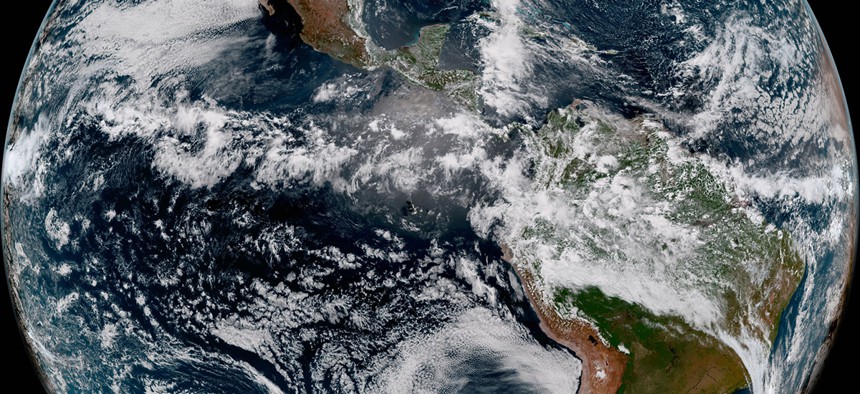NOAA’s Next-Gen Weather Satellite is Still Malfunctioning and May Not be Fixable

NOAA
The second satellite in NOAA’s $11 billion GOES program continues to experience issues with its most important instrument and officials still aren’t sure what’s wrong.
The National Oceanic and Atmospheric Administration’s newest weather satellite—part of the $11 billion Geostationary Operational Environmental Satellite constellation set to operate for the next 20 years—is broken and officials still aren’t sure what’s wrong or how to fix it.
Launched in March, the GOES-17 satellite was set to monitor weather events and natural disasters such as wildfires or volcanic eruptions in the western half of the United States, but officials identified cooling issues with the satellite’s primary instrument in May.
Officials told reporters Tuesday that two review teams consisting of NOAA, NASA and industry personnel continue to investigate what’s wrong with the Advanced Baseline Imager instrument and how to mitigate the loss to ensure weather forecasters on the ground continue to get high-quality satellite data.
In the meantime, GOES-17 remains in a holding pattern orbit 22,000 miles above the Earth’s surface, and the launch dates of two future GOES satellites, the next of which is scheduled for 2020, could be pushed back if experts and engineers aren’t able to figure out what went wrong with the older sibling satellite.
"There's no doubt that the problems we are experiencing with the cooling system are disappointing and not what we expected of GOES-17 when we launched,” said Steve Volz, assistant administrator for NOAA’s satellite and information service. “But we are committed to getting this right, and we will figure out what happened on [GOES-17] so it doesn’t happen with our other GOES satellites.”
Pam Sullivan, the GOES-R program director, said the loss in functionality has been traced to a loop heat pipe, an integral part of the Advanced Baseline Imager’s cooling system. The pipe carries a coolant called propylene and helps keep the instrument at its optimal temperature of -350 degrees Fahrenheit.
The pipe was made by Northrop Grumman, Sullivan said, and the company is working with officials on the ground to further investigate. The investigation suggests the most likely causes are mechanical damage to the pipe, an issue with gas inside the pipe or potentially foreign object debris, but no conclusion has been made. Tests could take up to three months, Sullivan said, and will eventually involve the manufacturer of the Advanced Baseline Imager, Harris Corp.
The cooling issue is causing the Advanced Baseline Imager instrument to work suboptimally. The instrument looks at the earth’s surface in 16 camera channels, but the cooling issue prevents all bands from operating around the clock. Depending on sun’s position, as many as six channels will only be able to work part-time. Other instruments aboard have not been affected.
Another review team is examining how to make use of existing satellites worldwide to mitigate the loss of capability in GOES-17. Thus far, officials said forecasters have not experienced any degraded forecast data.
“Right now we have an operational constellation serving us and we’re able to carry out the mission today without any degradation,” said Joe Pica, director of the National Weather Service’s Office of Observations. “We’re fully ingrained with the teams working to resolve this issue and optimize performance.
Pica said he had “confidence in the team that we’ll come up with a solution that makes GOES-17 a significant and valuable contribution to our capabilities.”






